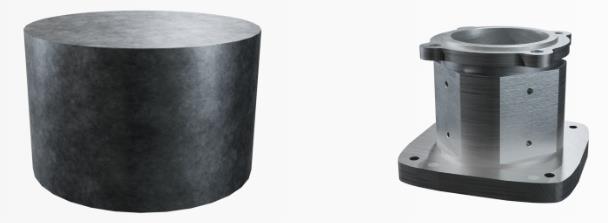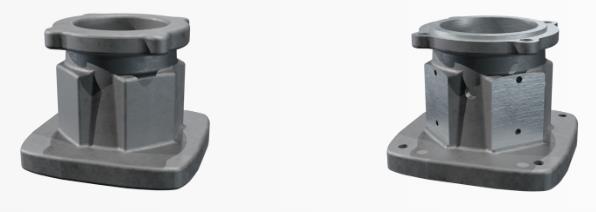
Casting parts vs. Conventional machining processing
COMPARISON OF MANUFACTURING PROCESSES
Casting parts vs. Conventional machining processing
Which manufacturing process provides the best possible quality at the lowest possible costs? Designers and product developers found an answer to this question during the development of a new drive train with a motor flange. In the design-to-cost project, the manufacturing processes of casting and pure machining, or metal cutting, were analyzed with respect to costs, procedures and benefits.
The initial situation:
A new component, the motor flange, was developed for the further development of conveyor technology. Designers and product developers questioned about how the new component could be manufactured quickly, reliably and economically.
The challenge:
Finding a manufacturing process for low to medium production quantities which provides the optimal quality at the lowest possible costs.
The procedure:
The motor flange was designed first. A prototype for tests and trials was constructed using the conventional machining. Once the test phase was completed, a mold was created based on this prototype. Then the motor flange was produced as a casting part.
The manufacturing processes of casting and machining were examined holistically for their costs and benefits as part of the design-to-cost method.
Comparison of manufacturing processes:
Machining process – conventional mechanical processing

Manufacturing a casted part with subsequent mechanical processing

Costs advantages in the production of casting parts are achieved starting at a production quantity of 43 components.
Conclusion:
Already starting at a series production of 43 pieces, the manufacturing of casting parts achieves a better cost-benefit ratio than conventional machining.
Complicated geometries can be realized using castings. The material utilization of the casting process is about five times higher than of the machining process: The final machining requires significantly less effort due to the near-net-shape mold. Any waste materials, such as metal chips, are completely recycled into the process cycle.
During the development phase, the prototype often still requires adjustments. It is advisable that the casting mold may only be created when the component will not be changed anymore. Therefore, it is common to start with machining at the beginning of the development phase and switch to casting afterward, as soon as the prototype has met all requirements.
From A for aluminum to Z for zinc – all metals of technical importance can be cast and are thus always tailor-made.
If any more information needed, pls contact:
Shenzhen Far East Tech Co., Ltd
 #2 Building,Ganghuaxing Industry Area,No.2 Chongqing Road, Qiaotou Cummunity, Fuyong Street, Baoan District
#2 Building,Ganghuaxing Industry Area,No.2 Chongqing Road, Qiaotou Cummunity, Fuyong Street, Baoan District
 18938890781
18938890781
Próximo :
WHICH ALUMINUM ALLOY BENDS BEST?Categorias
Novo Blog
© direito autoral: 2025 Far East Tech CO., Ltd. Todos os direitos reservados.

Rede IPv6 com suporte